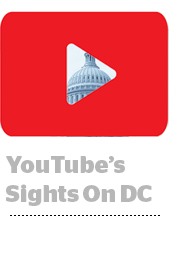 For YouTube, the recent election cycle was the best of times and the worst of times.
For YouTube, the recent election cycle was the best of times and the worst of times.
Multiple campaign sources think the Google-owned video network remained the single largest platform for political video dollars (aside from TV networks), despite Facebook’s meteoric rise.
“YouTube is the second most trafficked site in the US, so it played a large role in Bernie’s paid and organic strategy,” said Keegan Goudiss, a partner at Revolution Messaging and former director of digital advertising for Bernie Sanders’ primary campaign.
The Trump campaign used YouTube to target campaign messages, segmenting people by geography or persuasion status (so a known supporter would get an ad with directions to a polling location, while an undecided voter would see a relevant issue clip), said Molly Schweickert, head of digital at Cambridge Analytica and a digital buyer for the Trump campaign.
Political ad spenders are notoriously conservative about new ad channels and, facing a digital ecosystem plagued by quality concerns, they consolidated a significant majority of budgets with Google and Facebook.
YouTube stood out from other video sources “due to the high quality of inventory and ability to measure results,” Schweickert said.
The Real Feel
But while YouTube solidified its position as an essential piece of political advertising, it ceded status as a true political pulse point of the country.
For instance, in 2008, CNN incorporated questions from user-submitted YouTube videos into its presidential debate programming. This year, CNN fielded questions through a hashtag on Twitter, Facebook and Instagram.
While 2016 presidential campaigns and party organizations churned out video content and paid handsomely to promote it, YouTube didn’t drive cultural relevance like it did in 2008 or 2012, according to political experts. Obama campaign posts regularly logged millions of views, and other content creators produced videos like the “Yes We Can” mash-up that became a rallying cry for supporters, noted Ben LaBolt, a press secretary on both of Obama’s campaigns. He’s now a partner at the digital agency Bully Pulpit Interactive, ever since it bought his strategic communications firm The Incite Agency in September.
LaBolt isn’t pessimistic about YouTube’s standing for political advertisers – it’s gone from the only show in town to the biggest of two – but said that “while campaigns and politicians may be accustomed to more polished, produced video, Facebook and some others changed the game on videos feeling less polished and more authentic.”
Google is certainly aware that its content can feel more like slick TV spots than the intimate style associated with Snapchat and Facebook videos.
“We’ve found with candidates this year that content that’s more unpolished is better consumed, because it’s seen as authentic,” said Lee Dunn, Google’s head of campaigns and elections. She said there are creative best practices that Google works with candidates on, like looking directly into the camera or eschewing professional production in favor of self-shot, low-fuss videos.
The Social Spine
Two digital operatives, one from the Clinton campaign and one from the Republican National Committee (RNC), said on background that Google’s political account teams were built for paid media planning, but not necessarily with a news strategy.
The same RNC source said that YouTube was a good way to distribute video clips to TV network sites or that an ad posted to YouTube would get its attention on Twitter. “YouTube was like the fuse, but not the dynamite,” he said.
Working with Google was always accompanied by “data gathering with paid media in mind – like audience information and logging full views – whereas the rawer content on a platform like Snapchat or Facebook probably just lives there and is part of a more organic strategy.”
The Clinton campaign source added that, while Google had teams for Democrats and Republicans, YouTube could get “obscured by the targeting, targeting, targeting. And they don’t have someone like Peter Hamby [Snapchat’s head of news, hired from CNN in 2015, who hosted a political news program on the platform] spearheading organic use.”
Google’s Dunn acknowledged that her job focused on selling ads targeting YouTube viewers, but she said she worked with clients to use YouTube as a “social spine” – that is, as a measurement hub and a means to distribute videos across Twitter, Facebook and other media.
Tunnel Vision
Google’s strategy of working directly with candidates, parties and major political spenders had other consequences too. To maintain complete control, campaign operatives and parties instructed their other agencies to avoid buying on YouTube.
“We had a YouTube strategy we were executing with Google, and that means keeping a close eye on things like frequency capping or overall ad exposure,” said the Clinton campaign buyer. “Necessarily, that means, if we have our other vendors buying on YouTube on our behalf, it kind of muddies the water for that measurement.”
Google’s direct relationships siphoned political spend from the rest of the advertising ecosystem. Four executives from programmatic political agencies said that YouTube spending dropped this year at clients’ requests.
Two who agreed to share historical data showed YouTube going from 30%–50% of video budgets in 2012 and 2014 to around 10% this year. A third with data from only this election said that YouTube had dropped to under 5% of total media spend.
It’s hard to gauge whether these political media trends are good or bad for YouTube.
Twitter and Facebook supplanted YouTube this year as the most direct conduit to American political sentiment. Yet, YouTube soaked up ad dollars, while Twitter and Facebook dealt with trolls, abuse and propaganda.
And YouTube is still a powerful organic media cog for a political movement. Twitter featured prominently this year because Trump used it so voraciously, not because it is inherently better suited to building a coalition.
“Much of the live streaming and some of the best content about Bernie came from people posting it to YouTube, independent of any campaign direction,” Goudiss said. “That is what a 21st-century political movement looks like.”















